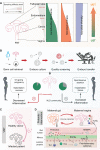Microbiome in Female Reproductive Health: Implications for Fertility and Assisted Reproductive Technologies
- PMID: 38862423
- PMCID: PMC11104452
- DOI: 10.1093/gpbjnl/qzad005
Microbiome in Female Reproductive Health: Implications for Fertility and Assisted Reproductive Technologies
Abstract
The microbiome plays a critical role in the process of conception and the outcomes of pregnancy. Disruptions in microbiome homeostasis in women of reproductive age can lead to various pregnancy complications, which significantly impact maternal and fetal health. Recent studies have associated the microbiome in the female reproductive tract (FRT) with assisted reproductive technology (ART) outcomes, and restoring microbiome balance has been shown to improve fertility in infertile couples. This review provides an overview of the role of the microbiome in female reproductive health, including its implications for pregnancy outcomes and ARTs. Additionally, recent advances in the use of microbial biomarkers as indicators of pregnancy disorders are summarized. A comprehensive understanding of the characteristics of the microbiome before and during pregnancy and its impact on reproductive health will greatly promote maternal and fetal health. Such knowledge can also contribute to the development of ARTs and microbiome-based interventions.
Keywords: Assisted reproductive technology; Female reproductive health; Microbial biomarker; Microbiome; Pregnancy.
© The Author(s) 2024. Published by Oxford University Press and Science Press on behalf of the Beijing Institute of Genomics, Chinese Academy of Sciences / China National Center for Bioinformation and Genetics Society of China.
Conflict of interest statement
The authors have declared no competing interests.
Figures



Similar articles
-
The Role of the Genital Tract Microbiome in Human Fertility: A Literature Review.J Clin Med. 2025 Apr 24;14(9):2923. doi: 10.3390/jcm14092923. J Clin Med. 2025. PMID: 40363959 Free PMC article. Review.
-
Effectiveness of a mixed lifestyle program in couples undergoing assisted reproductive technology: a study protocol.Reprod Health. 2023 Aug 1;20(1):112. doi: 10.1186/s12978-023-01652-6. Reprod Health. 2023. PMID: 37528465 Free PMC article.
-
Microbiome affecting reproductive outcome in ARTs.J Gynecol Obstet Hum Reprod. 2021 Mar;50(3):102036. doi: 10.1016/j.jogoh.2020.102036. Epub 2020 Dec 8. J Gynecol Obstet Hum Reprod. 2021. PMID: 33307241 Review.
-
The impact of the female genital tract microbiome in women health and reproduction: a review.J Assist Reprod Genet. 2021 Oct;38(10):2519-2541. doi: 10.1007/s10815-021-02247-5. Epub 2021 Jun 10. J Assist Reprod Genet. 2021. PMID: 34110573 Free PMC article. Review.
-
Female genital tract microbiome: the influence of probiotics on assisted reproduction.Rev Bras Ginecol Obstet. 2024 Dec 4;46:e-rbgo82. doi: 10.61622/rbgo/2024rbgo82. eCollection 2024. Rev Bras Ginecol Obstet. 2024. PMID: 39669302 Free PMC article. Review.
Cited by
-
Vaginal Dysbiosis in Infertility: A Comparative Analysis Between Women with Primary and Secondary Infertility.Microorganisms. 2025 Jan 17;13(1):188. doi: 10.3390/microorganisms13010188. Microorganisms. 2025. PMID: 39858956 Free PMC article.
-
Navigating the Microbial Landscape: Understanding Dysbiosis in Human Genital Tracts and Its Impact on Fertility.Cureus. 2024 Aug 16;16(8):e67040. doi: 10.7759/cureus.67040. eCollection 2024 Aug. Cureus. 2024. PMID: 39286717 Free PMC article. Review.
-
Surgical Technique and Fertility Outcomes: A Comprehensive Review of Open and Laparoscopic Cystectomy in Women of Reproductive Age.Cureus. 2024 Oct 10;16(10):e71179. doi: 10.7759/cureus.71179. eCollection 2024 Oct. Cureus. 2024. PMID: 39525144 Free PMC article. Review.
-
Expert Opinion: Place in Therapy of Probiotics in Infertility and Recurrent Implantation Failure.Cureus. 2025 Mar 24;17(3):e81067. doi: 10.7759/cureus.81067. eCollection 2025 Mar. Cureus. 2025. PMID: 40271314 Free PMC article. Review.
-
Autophagy and Female Fertility: Mechanisms, Clinical Implications, and Emerging Therapies.Cells. 2024 Aug 14;13(16):1354. doi: 10.3390/cells13161354. Cells. 2024. PMID: 39195244 Free PMC article. Review.
References
Publication types
MeSH terms
Grants and funding
LinkOut - more resources
Full Text Sources
Medical

